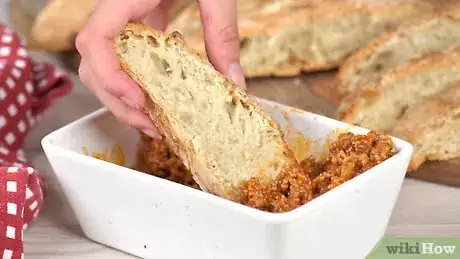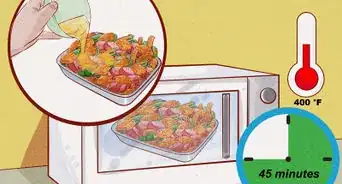This article was co-authored by wikiHow Staff. Our trained team of editors and researchers validate articles for accuracy and comprehensiveness. wikiHow's Content Management Team carefully monitors the work from our editorial staff to ensure that each article is backed by trusted research and meets our high quality standards.
There are 14 references cited in this article, which can be found at the bottom of the page.
The wikiHow Culinary Team also followed the article's instructions and verified that they work.
This article has been viewed 24,457 times.
Learn more...
With a chewy exterior, moist interior, and plethora of sauce-catching holes, pugliese bread is a great loaf to enjoy alongside a flavorful meal. In Italy, it’s traditionally used as a vessel to sop up delicious sauces and soups, but it can also be used to create other dishes, like strata and bruschetta. If you’re feeling adventurous, try your hand at making Pugliese bread at home—there’s nothing better than a warm, crusty, homemade loaf of bread!
Ingredients
Simple Pugliese Bread
- 4 cups (520 grams) of all-purpose flour
- 1.5 cups (350 mL) of water
- 1/8 package (1 gram) of instant dry yeast
- 1 tablespoon (17 grams) of table salt
- Olive oil
Makes one loaf of bread
Steps
Following Traditional Bread Etiquette
-
1Eat pugliese bread along with non-pasta parts of your meal. Traditionally, Italians never eat bread alongside pasta, though that may seem a little bizarre if you live in the US. If you have sauce left over once your pasta is gone, you can sop it up with a piece of bread. Instead, eat pugliese bread along with other parts of the meal, like soup, salad, or a main entree.[1]
- Though Italians make and eat a lot of carb-based dishes, they try not to pair one starch with another at a single time.
-
2Enjoy bread before a meal only if it’s topped with olive oil or other ingredients. In Italy, you almost always wait and enjoy your bread along with other food. The exception to the rule is when the bread itself is the appetizer, like in the case of pugliese topped with warm tomatoes and onions, or if the chef drizzled it with specialty olive oil. In that case, enjoy the bread when it comes out and is still warm![2]
- Italian restaurants in the United States usually bring out a basket of bread before your meal is served so you have something to enjoy while you wait, so just take stock of where you are. Different countries have different customs.
Advertisement -
3Use your hands to rip off bite-sized pieces of bread. The idea here is that you never want to bring food to your mouth that you aren’t going to eat. Rip a small piece of bread with your hands, dip that piece of bread in soup or a sauce, or top it with a bite from your appetizer or entree.[3]
- Generally, you won’t get butter along with your bread at a restaurant in Italy. However, if you’re in the States and want to butter your pugliese bread, butter a single bite-sized piece at a time as you eat rather than buttering an entire slice.
-
4Avoid dipping your pugliese bread in olive oil and vinegar. If you’re in Italy, you’ll rarely see restaurants offering plates of oil and vinegar as a dipping sauce, and your server might get quite offended if you ask. Remember, eat bread along with other foods and flavors during your meal.[4]
- Traditionally, oil and vinegar are exceptional ingredients used to enhance the flavors of other elements. Using them as a dipping sauce is seen as wasteful.
- Of course, in the comfort of your own home or Italian restaurants in the United States, dipping bread in oil is quite ordinary and delicious!
Making Other Dishes with Pugliese Bread
-
1Visit an Italian bakery to buy a fresh loaf of pugliese bread. If you’re not in Italy and want to try this delicious Italian bread, the best place to get it is from a specialty bakery. Traditionally, it’s a loaf of bread from southern Italy and has a thick, chewy crust and soft, airy interior.[5]
- If you don’t have an Italian bakery in town, stop at a local Italian restaurant and ask if you can buy a loaf of bread directly from them.
-
2Top toasted pugliese bread with fresh bruschetta for a tasty appetizer. Cut a loaf of pugliese bread into 1⁄2 in (1.3 cm) slices. Put the slices onto a grill, in a toaster, or under the broiler for a few minutes until they turn golden-brown. Rub each slice with a clove of garlic and drizzle them with olive oil. Top each piece with bruschetta made from diced tomatoes and fresh basil marinated in extra-virgin olive oil and balsamic vinegar.[6]
- If you feel the pieces of bread are too large, cut them in half after you’ve sliced the loaf.
- If the tomato and basil mixture is really wet, use a slotted spoon to put it on the bread. This will keep the bread from getting overly soggy.
-
3Turn a loaf of pugliese bread into strata for a filling, decadent meal. Brown 2 bell peppers and 12 ounces (340 g) of Italian sausage in a skillet. In a bowl, whisk together 3 cups (710 mL) of half-and-half, 10 eggs, 1/4 cup (22.5 grams) of grated parmesan cheese, 2 tbsp (3.25 grams) of chopped, fresh parsley, and 1.5 tsp (9 grams) of salt. Rip the loaf of bread into 1 in (2.5 cm) cubes and put half of them in the bottom of a buttered 9 by 13 in (23 by 33 cm) baking dish. Sprinkle 1.5 cups (337 grams) of mozzarella cheese over the bread, followed by the browned peppers and sausage. Add the rest of the bread and pour the egg mixture over the top. Let the liquid soak into the bread for 30-60 minutes. Top with an additional 1/2 cup (112 grams) of mozzarella cheese and bake it in the oven at 325 °F (163 °C) for 50 minutes.[7]
- If you want, cut the recipe in half and bake it for about 35 minutes.
- Strata is often eaten for breakfast, but it’s delicious at any time of day!
- You could prep this dish the night before, cover it with plastic wrap, and let it rest in the fridge overnight. Just take it out of the refrigerator while the oven preheats in the morning.
-
4Enjoy a simple breakfast by making eggs-in-a-hole with pugliese bread. Slice off a nice, thick piece of bread and use a cup or cookie cutter to remove a 2 in (5.1 cm) circle from the center. Heat some butter or oil in a skillet, then fry the bread and the round until they start to brown. Flip over the bread, and gently break an egg into the hole. Turn the heat to medium-low and cook the eggs until the whites are completely opaque. Slide the bread out of the skillet with a spatula and enjoy![8]
- This is a great way to use up bread that is starting to get a little stale.
-
5Use stale bread to make other dishes rather than throwing it out. If you have a loaf of pugliese bread at home that has started to get hard, don’t despair! You can use it to make all kinds of other dishes, like pappa al pomodora, croutons, bread pudding, panzanella, and more.[9]
- To make fast and delicious croutons, rip up your leftover pugliese bread into about 1⁄2 in (1.3 cm) pieces. Fry them in 1⁄3 in (0.85 cm) of hot extra-virgin olive oil (EVOO) on one side for 30-60 seconds, then flip and fry them for another 60 seconds. Use tongs to remove the croutons from the pan and let them cool on a paper-towel-lined plate. Sprinkle them with salt and pepper and add them to soups and salads![10]
Baking a Simple Pugliese Loaf
-
1Combine the flour, water, and yeast in a large, clean mixing bowl. Measure 4 cups (520 grams) of all-purpose flour, 1.5 cups (350 mL) of water, and 1/8 package (1 gram) of instant dry yeast into a mixing bowl. Stir the ingredients with a large wooden spoon until they come together.[11]
- This recipe is for a very basic, simple loaf of pugliese bread. There are more intricate recipes than span a couple of days if you want to try a more advanced version.
-
2Flour a work surface and knead the dough for about 10 minutes. Sprinkle a clean counter or table with a light dusting of flour and pour out the dough. Push one side of the dough forward with the palm of one hand, pull the dough back toward your body, and push the side again with the palm of your hand. Continue doing this so you’re working the dough in a circular motion and consistently pushing and pulling.[12]
- The dough will be very sticky and wet at the beginning, so don’t worry if it’s sticking to your hands.
- If you have a stand mixer with a dough hook, you could use that instead of kneading the dough by hand. Just mix it on medium speed for about 10 minutes.
-
3Add 1 tbsp (17 grams) of salt to the dough and knead it for another 5-7 minutes. Simply pour the salt right on top of the dough and resume kneading. As the dough progresses, will get shiny and pull away from the table as it gets less sticky.[13]
- If you’re using your stand mixer, follow the same instructions. Mix the dough on medium speed until it starts to pull away from the mixing bowl walls.
-
4Grease the interior of a large mixing bowl with olive oil. Pour about 1 tablespoon (15 mL) of olive oil into the bowl and use a paper towel to spread the oil around the sides of the bowl. Make sure there are no dry spots; otherwise the dough will stick to the bowl.[14]
- Make sure to use a large bowl for this process, as it’ll need to contain the dough as it rises and triples in size.
-
5Put the kneaded dough into the oiled bowl and let it rise for 2-3 hours. When you put the dough into the bowl, flip it over once to coat the entire thing in olive oil—that’ll keep it from sticking as it rises and will also help keep it from getting a crust. Let the dough rest until it has tripled in size.[15]
- You may want to cover the bowl with a cotton towel to keep any bugs or dust from falling in.
- Placing the bowl inside a microwave (without turning the microwave on) can help the dough rise, especially if you live in a colder climate.
- It can be hard to tell how much dough has risen when it’s in a sloped bowl. Mark the dough level with a piece of masking tape on the outside of the bowl at the beginning so you can see how far it rises past that point after 2-3 hours.
-
6Preheat your oven to 500 °F (260 °C) and divide the dough into two loaves. Put a baking stone or something similar into the oven while it preheats. Gently transfer the dough from the bowl to a floured surface, cut it in two with a knife or bench scraper, and shape those pieces into ovals.[16]
- These are somewhat rustic loaves, so it’s okay if they aren’t the same size. If you want them to be perfectly equal, weigh the dough on a kitchen scale and measure the exact proportions.
- If you don’t have a baking stone, you could use a dutch oven, a cast-iron pan, or even a cookie sheet lined with parchment paper.
-
7Put the loaves on floured parchment paper and let them rise for 45 minutes. Lay two pieces of parchment paper on your counter and heavily flour them. If you don’t have parchment paper, you could also flour two cotton towels. Set the shaped loaves on the parchment paper and let them rest until they’ve doubled in size.[17]
- If you do use a kitchen towel, make sure it’s 100% cotton. Blends can easily get their fibers stuck in the dough and could be difficult to remove later on.
-
8Flip the dough onto the baking stone and score the loaves. Take the baking stone out of the oven and set it on a protected surface. Gently flip the parchment paper over to transfer the loaves to the stone and peel the paper away. Use a lame or sharp razor to make three 2 in (5.1 cm) slashes over each loaf.[18]
- A lame is a special baker’s tool used to make slashes in loaves of bread before they go into to oven. This process is called “scoring.”
- Be very, very careful when moving the baking stone. It’s scorching and could easily burn you. Wear oven mitts and be mindful of your hands.
-
9Add a pan of ice cubes to the oven and cook the loaves for 20 minutes. Simply get an oven-safe container, fill it with ice cubes, and put it on the bottom of the oven. Replace the baking stone with your scored loaves in the oven, close the door, and set a timer for 20 minutes.[19]
- The ice cubes will melt in the oven and create steam, forming a beautiful, chewy crust.
-
10Reduce the temp to 425 °F (218 °C) and cook the bread for 25 more minutes. When you reduce the temperature, also remove the container with ice cubes. Bake the bread for the additional 25 minutes or until the exterior is a deep, rich brown.[20]
- Depending on your oven, your loaves may need a few minutes more or less of cook time in the oven.
-
11Remove the loaves from the baking stone and let them rest for 1-2 hours. Set the loaves on a cooling rack. The bread will still be baking and setting when you remove it from the oven. If you cut into it too soon, it’ll compress the dough and ruin the texture.[21]
- If you want to get really technical, insert a food thermometer into the bottom of one of the loaves. The temperature should reach about 190 to 210 °F (88 to 99 °C).
Warnings
- Be extremely careful when baking bread. Your oven will be set to a very high temperature, so always use oven mitts and watch out for steam when you open the oven door.⧼thumbs_response⧽
Things You’ll Need
Baking a Simple Pugliese Loaf
- Measuring cups and spoons
- Mixing bowls
- Wooden spoon
- Paper towels
- Stand mixer (optional)
- Cotton towels
- Baking stone
- Parchment paper
- Knife or wrench scraper
- Lame or razor
- Cooling rack
- Oven mitts
References
- ↑ https://blog.seeitalytravel.com/11-rules-for-eating-in-italy
- ↑ https://www.elizabethminchilli.com/2017/10/10-rules-eating-bread-italy/
- ↑ https://www.seriouseats.com/2014/03/manner-matters-bread-butter-basics.html
- ↑ https://youtu.be/aBxayt-WKDQ?t=181
- ↑ http://ciuitaly.com/blog/files/bread-italy.php
- ↑ https://www.thekitchn.com/bruschetta-22925569
- ↑ https://www.foodnetwork.com/recipes/food-network-kitchen/italian-sausage-and-pepper-strata-5478374
- ↑ https://www.epicurious.com/recipes/food/views/egg-in-the-middle-51150000
- ↑ https://www.foodnetwork.ca/article/genius-ways-to-use-stale-bread/
- ↑ https://www.epicurious.com/recipes-menus/how-to-make-olive-oil-fried-croutons-article
- ↑ https://www.marthastewart.com/335619/pugliese-bread
- ↑ https://www.marthastewart.com/335619/pugliese-bread
- ↑ https://www.marthastewart.com/335619/pugliese-bread
- ↑ https://www.marthastewart.com/335619/pugliese-bread
- ↑ https://www.marthastewart.com/335619/pugliese-bread
- ↑ https://www.marthastewart.com/335619/pugliese-bread
- ↑ https://www.marthastewart.com/335619/pugliese-bread
- ↑ https://www.thekitchn.com/how-to-score-bread-loaves-before-baking-236642
- ↑ https://www.thekitchn.com/food-science-tip-add-steam-whe-76586
- ↑ https://www.marthastewart.com/335619/pugliese-bread
- ↑ https://www.epicurious.com/expert-advice/how-to-glaze-bake-and-cool-bread-loaves-at-home-article































































